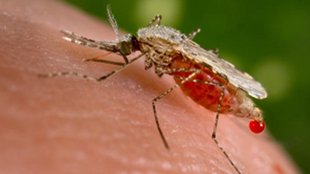A hungry mosquito is at best a nuisance; at worst, it is a transmitter of deadly diseases.
Now, researchers have discovered a way to stop mosquitoes biting — by using human ‘diet’ drugs to trick them into feeling full. The scientists suggest that the drugs could one day be used to control the spread of diseases. Their results are reported in Cell on 7 February1.
“It’s an excellent study,” says Clare Strode, a mosquito biologist at Edge Hill University in Ormskirk, UK. There’s a long way to go before the method can be used in the wild, she says, but “as a proof of principle, it’s very promising”.
A diet plan for mosquitoes
Female Aedes aegypti, like other mosquito species, feed on blood to get the protein they need to produce their eggs, and spread diseases such as dengue in the process. But once the mosquitoes have had their blood fix, they stop biting until they’ve laid their eggs several days later.
Leslie Vosshall, a neurobiologist at the Rockefeller University in New York City, wondered whether she could hijack this biological process to switch off a mosquito’s appetite.
Previous research had suggested that a mosquito’s desire to feed is controlled by neuropeptides, molecules used by the nervous system to communicate2. Vosshall and her team suspected that neuropeptide Y (NPY) receptors might be particularly important, because they form part of the molecular pathway involved in food-seeking behaviour for many animals — including humans.
Some human appetite-suppressant drugs already target the NPY receptors, so Vosshall decided to take a “completely zany” approach: feed these drugs to mosquitoes and see what happens.
The method worked: mosquitoes that fed on a solution containing NPY-activating drugs were much less likely to approach a human-scented ‘lure’ than were the control group, and their appetites remained suppressed for two days.
Gene-edited proof
Because the drugs were originally designed to work on human receptors, Vosshall’s team wanted to find out where they were acting in mosquitoes. They cultivated 49 different mosquito proteins in tissue culture and examined which ones responded to the drug. One stood out: NPY-like receptor 7 (NPYLR7).
The team then used CRISPR gene-editing to create mosquitoes that had a mutation in the NPYLR7 gene that prevented it from functioning properly. When they fed the drug to these modified mosquitoes, it no longer had an effect, suggesting that NPYLR7 gene was the key to regulating the insects’ appetites.
Vosshall says that a project that started “as kind of a lark” gained momentum after a representive from the philanthropic Bill & Melinda Gates Foundation in Seattle, Washington — which funds research on diseases transmitted by mosquitoes such as dengue and malaria — expressed enthusiasm at early results presented at a conference. “That encouraged me,” she says. “If the major funder of public health worldwide felt like it wasn’t science fiction — we were going to do it.”
But the Gates representative also pointed out that a method for controlling mosquitoes in the wild couldn’t rely on a human drug, which might have unwanted effects on people. So Vosshall’s team began screening hundreds of thousands of small molecules to find one that activated the NPYLR7 receptor in mosquitoes — and didn’t work in humans. Eventually, they identified six promising compounds able to suppress mosquito appetite.
Into the wild
Vosshall says that these six molecules could be used outside the lab to reduce disease transmission. “If today I could convince every mosquito on Earth to drink […] our drug, every mosquito on Earth would lose its appetite for 2–3 days,” she says. Less biting would mean less disease transmission. “That would be the dream.”
But Vosshall acknowledges that this possibility is still a while away. Even the most potent compound the team identified need to be administered at a very high concentration to affect the mosquitoes’ behaviour, which would make it prohibitively expensive to deploy in the field. Vosshall hopes to partner with medicinal chemists to tweak the chemistry and create a more powerful molecule.
The team would also need to work out how to lure the mosquitoes to feed on these compounds, without also attracting other insects such as butterflies. That’s one major barrier to using this type of technique in the wild, says Oliver Brady, an epidemiological modeller at the London School of Hygiene and Tropical Medicine.
To attract A. aegypti, lures need to mimic humans, giving off the right odour and concentration of carbon dioxide, for example. “It ends up being a very complicated and very expensive trap,” he says.







